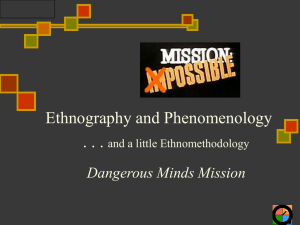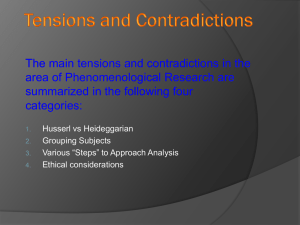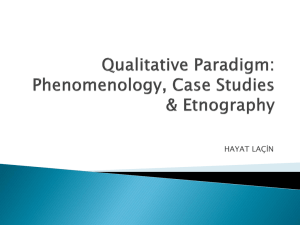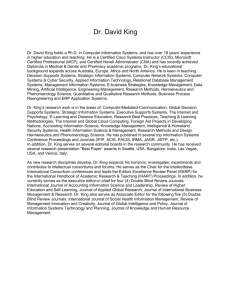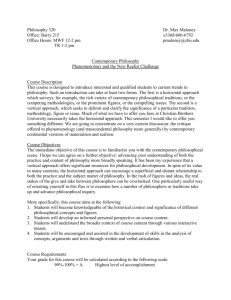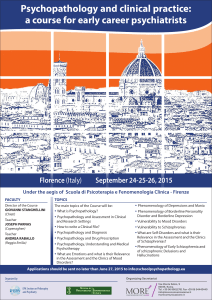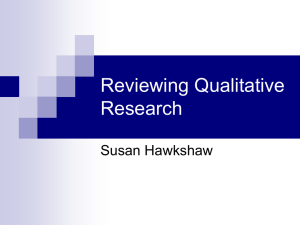THE PHENOMENOLOGY OF EMBODIED AGENCY
advertisement
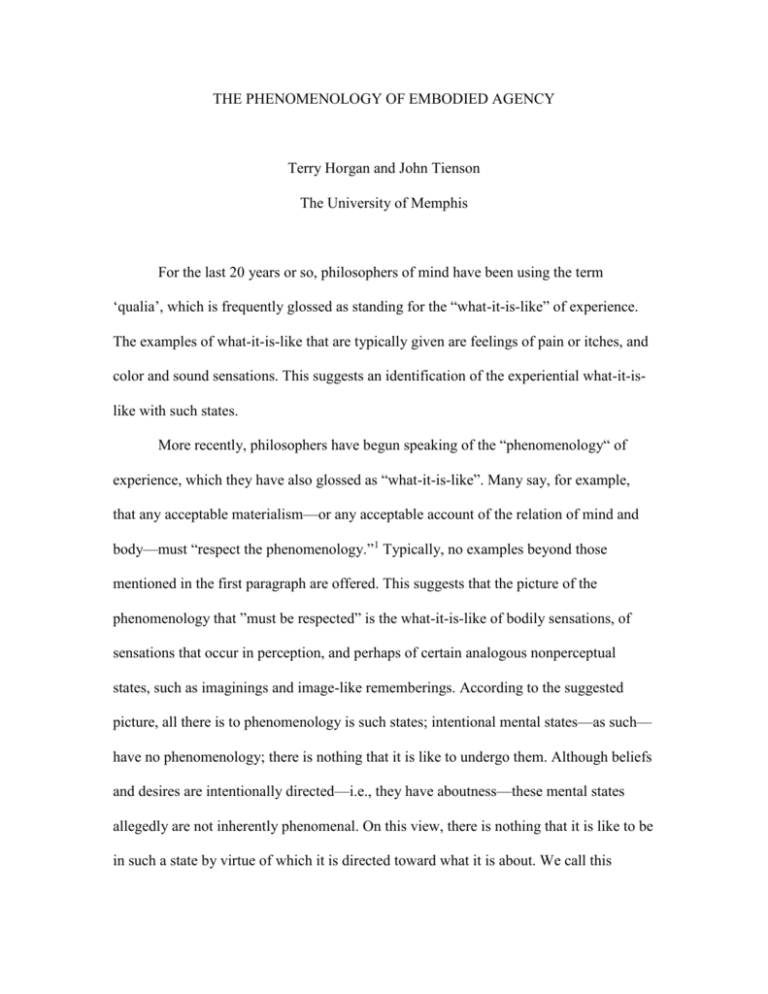
THE PHENOMENOLOGY OF EMBODIED AGENCY Terry Horgan and John Tienson The University of Memphis For the last 20 years or so, philosophers of mind have been using the term ‘qualia’, which is frequently glossed as standing for the “what-it-is-like” of experience. The examples of what-it-is-like that are typically given are feelings of pain or itches, and color and sound sensations. This suggests an identification of the experiential what-it-islike with such states. More recently, philosophers have begun speaking of the “phenomenology“ of experience, which they have also glossed as “what-it-is-like”. Many say, for example, that any acceptable materialism—or any acceptable account of the relation of mind and body—must “respect the phenomenology.”1 Typically, no examples beyond those mentioned in the first paragraph are offered. This suggests that the picture of the phenomenology that ”must be respected” is the what-it-is-like of bodily sensations, of sensations that occur in perception, and perhaps of certain analogous nonperceptual states, such as imaginings and image-like rememberings. According to the suggested picture, all there is to phenomenology is such states; intentional mental states—as such— have no phenomenology; there is nothing that it is like to undergo them. Although beliefs and desires are intentionally directed—i.e., they have aboutness—these mental states allegedly are not inherently phenomenal. On this view, there is nothing that it is like to be in such a state by virtue of which it is directed toward what it is about. We call this 2 picture separatism, because it treats phenomenal aspects of mentality and intentional aspects of mentality as mutually independent, and thus separable.2 We maintain that separatism is quite wrongheaded—that phenomenology and intentionality are essentially intertwined. For instance, there is a phenomenology of occurrent belief. There is something that it is like to believe, for example, that there is no one behind you.3 What it is like to have this belief is quite different from what it is like for one of the participants at Language and Mind III to believe she or he was in Lisbon on May 28, 2001. And there is something that it is like to want to finish this paper on time, that is quite different from the what-it-it-like of the just-mentioned beliefs, as all are different phenomenologically from what it is like to hope it does not rain tomorrow. What it is like to be in any such state—or undergo such a process—is not solely a matter of having certain imagery. Imagery, of itself, is not about anything. Nor is it a matter of rehearsing to yourself certain sentences of your language. Hence the “phenomenology” to be respected in accounting for the relation between mind and body includes far more than the typical examples of qualia and their kin in memory and imagination.4 We have written a paper (Horgan and Tienson, 2002) that makes this point with relevant examples, 1 As Brian McLaughlin did, for example, at Language and Mind III; cf. also Loar, forthcoming. Full-fledged separatists hold that the paradigmatically phenomenal aspects of mentality are not intentional. Separatism was represented at Language and Mind III by at least the papers of Tim Crane and Jaegwon Kim. Kim argued, in a way that firmly presupposed the separatist framework, that we can get more than half way to naturalizing the mental, but not all the way. The leading idea is that the intentional aspects of mentality can be naturalized via “functionalization,” but that the phenomenal aspects resist naturalization. 3 There is a good deal that is implicit in the content of such a belief. Someone in the room behind you does not falsify the belief. Someone many miles away behind you on Earth (or directly behind you in a space station) does not falsify the belief. But surely all that is understood, not conscious, not part of the phenomenology. 4 As philosophers have begun to recognize this, the term ‘qualia’ seems to be used differently by different philosophers. Some use it to encompass all phenomenal aspects of mentality. Others restrict it to the typical examples—sensations and the like. The term itself goes back at least to C.I. Lewis, Mind and the World Order (1929); Lewis used it for the given in experience. Because of this ambiguity, we for the most part avoid the term. 2 3 explanations, and arguments, and then goes on to draw negative conclusions concerning much of the received wisdom of contemporary philosophy of mind.5 We also maintain that there is a phenomenology of (embodied) agency that has an even more obvious what-it-is-likeness than do occurrent beliefs and desires. This what-itis-like of agency is neither image-like nor does it (necessarily) involve linguistic imagery. One aim of this paper is simply to point out some of the various kinds of phenomenology—what-it-is-likeness—of agency. The phrase ‘the phenomenology of embodied agency’ can usefully be seen as ambiguous. There is the obvious sense of the phenomenology of doing—what it is like to act in a certain way—and the difference in what it is like between doing one thing and doing another. But there is also the phenomenology of experiencing the other as embodied agent, experiencing the other as doing something. So a second, collateral, aim of this paper is to provide a preliminary taxonomy of the phenomenology of agency in both senses (since the two kinds phenomonology are intertwined). We conclude the paper with some brief observations about the potential implications of the phenomenology of embodied agency for three philosophical topics. One topic is the philosophical project of “naturalizing” various mental phenomena. The second topic is a long-standing issue concerning human interpretation, which has surfaced in its most recent guise in the analytic tradition as the dispute between “theorytheory” and “simulation-theory.” The third topic is the relation between actions, reasons, and causes. 5 For several recent treatments of the relation between phenomenology and intentionality that are similar in spirit to what we say in that paper, see the discussions of Flanagan (1992), Strawson (1994), Siewert 4 1. A Taxonomy of the Phenomenology of Embodied Agency Here is our proposed taxonomy. (Boldface represents those types of phenomenology of agency that we think are most common.) THE PHENOMENOLOGY OF EMBODIED AGENCY A. Phenomenology of Doing A.1. With Deliberation A.1.a. Reflective Equilibium A.1.b. Practical Syllogism A.2. Not With Deliberation A.2.a The Reason is Conscious but not Salient A.2.b. The Reason is Conscious, but is not Accessible A.2.c. Average Everyday B. Phenomenology of Understanding the Other as Embodied Agent B.1. Reflective Understanding B.1.a. Little Scientist B.1.b. Simulation/Projection B.2. Seeing What Others Are Doing B.2.a. Average Everyday B.2.b. Special B.3 Just Getting It We elaborate upon this taxonomy in the next two sections. (1998), and Loar (forthcoming). 5 2. The Phenomenology of Doing. Under category A.1.a, “Reflective Equilibrium,” we include the fairly common cases where many different factors are weighed in making a decision. These run the gamut from the mundane to important life decisions such as what car to buy and whether to change jobs when one has an offer. An example of a “mundane” reflective equilibrium decision might be deciding what to have for lunch in a restaurant. Factors that might make a difference in such a decision, in addition to price and one’s preferred dishes on the menu, include what one has had for lunch recently, what one expects to have for dinner, one’s past experiences at this restaurant, whether one expects to eat at this restaurant again, and what others in one’s party are ordering. Typically, when one comes to such a decision, one can point to reasons, but phenomenologically no single factor or set of factors are experienced as the ones that resulted in the choice.6 A ubiquitous philosophers’ example of category A.1.b., “Practical Syllogism,” is one’s going to the refrigerator because of an occurrent desire for a beer and an occurrent belief that there is beer in the refrigerator. This example is meant, of course, as a representative of a vast variety of belief/desire explanations of actions. The picture of belief and desire conspiring to cause an action is the received view of acting for a reason. We have boldfaced the entire category A.2, “Not with Deliberation,” because most of what people do is done “as a matter of course.” Start with A.2.c, “Average Everyday.” Consider Jane’s route to get her beer from the fridge. She would probably go from the living room to the kitchen by the most direct route. But what does this mean? It does not mean that she would go in a straight line. She would go though the doors A common connectionist metaphor is helpful here. The network “settled” into a solution, based on “weights”—weighted connections between units. In any connectionist account of consciousness, the 6 6 between the living room and the kitchen. She does not have to think about this; she does not think, “Should I go in a straight line, or through the doors?” She just does it. Even if there is a choice of doors into the kitchen, so that she must “choose” one, she does not have to think about which door to take. She just sees, for example, which doorway is more congested and then goes through the other door. But Jane is not compelled to take the most direct route. She might go out the front door, around the house, and into the kitchen by the back door, in order to avoid someone in the room between the living room and the kitchen. Here we might plausibly say that she alters the manner in which she does something because of a desire—to avoid a certain person—and a relevant belief—that she can avoid that person by not going in a certain room. These are conscious aspects of her mental processing, with a distinctive phenomenology. Another example of average everyday acting: One gets dressed in the morning. Often one simply does this, without thinking. But of course, sometimes one’s as-amatter-of-course getting dressed is punctuated by deliberation about what to wear. Such deliberation may approach either of the subcategories A.2.a or A.2.b. Also falling under A.2.c, “Average Everyday,” is making plays in sports such as soccer and basketball. In such sports, athletes are constantly making decisions, as coaches and commentators constantly remind us.7 What goes for sports activity goes for many complex physical activities that everyone engages in, such as driving a car or other vehicle, or walking about in a crowded shopping area. Or consider crossing a busy weights will be phenomenologically inaccessible. See Horgan and Tienson 1996. 7 These decisions are made against a background understanding of the situation. The same physical stimulus would get different responses depending on, e.g., the strategic situation (both ideally and in practice). 7 Lisbon street. Those of us in Lisbon for the first time have to think about whether we can cross now or whether we should wait for the light to turn green. If any of us were to stay in Lisbon for a while, we would not have to think about it. Each of us would just cross or wait, as a matter of course, without thinking about it. Turn now to category A.2.a, “Reason is Conscious but not Salient,” and category A.2.b, “Reason is not Conscious but is Accessible.” It is not always easy to distinguish them, and perhaps they both blend into A.2.c, “Average Everyday.” Most activities that sometimes fit one of these categories also can fit the others as well. Among the best examples of activities where reasons are merely accessible or at least not salient are familiar, but not everyday, activities. Suppose, for example, that you decide in the morning to cook meatloaf for dinner. There are many things that can be said about such a mundane activity, but we will restrict ourselves to three. First, having earlier assured yourself that you have the ingredients for your recipe for meatloaf, at some particular time in the evening you will begin the process of assembling the meatloaf. There may be no more phenomenological accompaniment to this than thinking, “it’s time to start cooking,” if there is even this phenomenologically. Perhaps you just go to the kitchen and get to work. Second, there are several steps to preparing a meatloaf. You must, for example, slice an onion. You do this, in a sense, because it is necessary to make a meatloaf. But phenomenologically, you may just do it; it is a step in a process (though, importantly, the steps need not come in a fixed order). It seems extraordinarily stilted, in terms of the phenomenology of the matter, to say that you slice the onion because you want to cook a meatloaf and believe that slicing an onion is necessary for cooking a meatloaf. But of 8 course, if someone asked why you were slicing the onion, you could say “because I’m making meatloaf.” Third, consider the case where you depart from your usual recipe because of dietary restrictions of someone who will be sharing your meal, and in particular, someone for whom you have cooked meatloaf before. You certainly have a reason for altering your recipe in a certain way, but our sense is that this need not, as such, become phenomenologically salient, or even thought of. That’s just the way you do meatloaf when she’s here. The general point here is that most of what we do is, simply, doing what we do in this context, and does not require a consciously considered reason. Sometimes reasons can be asked for and given. Sometimes, as in the case of most Average Everyday activities (category A.2.c), asking for reasons is otiose. Perhaps the actions about which we deliberate are more interesting than these, but deliberative actions take place against a background of routine getting on in the world that requires little or no conscious deliberation. 3. The Phenomenology of Understanding the Other as Embodied Agent Most of the time when one understands what other people are up to, one just sees what they are doing—category B.2. Usually this falls under subcategory B.2.a, “Average Everyday,” of category B.2, “Seeing What Others Are Doing.” Someone is cooking, or cleaning up, or eating, or shopping, or playing a game. One can see that people are doing such things even when one is in a foreign location and the way they are being done is quite unfamiliar. At least at a surface level, one also understands why such things are being done. So we see people doing things; that is, we see agency in the world. This 9 should not be surprising, although we think it needs to be said. One also sees, say, tables and chairs as table and chairs, not as simple colored expanses. And one sees, for example, Fords, Chevies and Mercedes as Fords, Chevies, and Mercedes. Seeing that a Mayan woman is cleaning her home—seeing her as cleaning—is the same sort of thing in the case of seeing actions and processes as seeing a chair as a chair is for seeing objects. What we have in mind under the subcategory A.2.b, “Special,” of category A.2, “Seeing what Others Are Doing,” are rare or extraordinary actions, such as someone rescuing a person from a burning car or rescuing a swimmer in danger of drowning. You may never have seen anyone doing such a thing, but if you were to see it, you would automatically know what you were seeing. Furthermore, if you saw a person trapped in a burning car or a swimmer in trouble, you would most likely know, without conscious reflection, what you were seeing. Occasionally, when one fails to just see what other persons are doing, one’s phenomenology of interpreting others falls under category B.1, “Reflective Understanding.” The subcategory labels B.1.a, “Little Scientist,” and B.1.b., “Simulation/Projection,” are meant to approximate theory/theory and simulation/theory respectively. We suppose that sometimes one tries to figure out what someone is doing by consciously reasoning from generalizations or general rules. Perhaps this is most likely when one observes or hears about activities that have no close analogue in one’s own culture. Then one might apply generalizations one has learned concerning the foreign culture. We also suppose that sometimes one tries to figure out what someone is up to, or what someone will do, by somehow consciously “putting oneself in the place of the other.” But in the vast majority of contexts where one understands others as agents 10 acting for reasons, one’s phenomenology in so doing is not the phenomenology of reflective understanding at all—neither the phenomenology of conscious simulation/projection, nor the phenomenology of consciously applying generalizations to the case at hand. As we said, normally one just sees what others are doing, with the same phenomenological immediacy with which one sees that a particular car is a Mercedes. Morover, attempts to understand others reflectively, in either the “Little Scientist” manner or the “Simulation/Projection” manner, take place themselves against a background of routine automatic understanding of what others are doing. And we think this applies to a large extent to the processing involved in understanding narrative accounts of others, both historical and fictional. One understands the recounted events as taking place in the context of average everyday being-in-the-world. The final category to discuss is B.3, “Just Getting It.” This category differs from B.2, “Seeing what Others are Doing,” because, although phenomenologically it involves neither simulation nor theoretical thinking, it is not something that almost everyone will automatically get. (By way of analogy, compare the phenomenon of not getting a joke at first, and then suddenly getting it.) Here is a (true) just-getting-it story that John Tienson told at the presentation of this paper at Mind and Action III. We flew to Lisbon and took a taxi cab from the airport to the hotel. The way one gets a cab at the Lisbon airport is this. The cabs line up single file, and then at the point where passengers are picked up, the line of cabs splits into two. People waiting for cabs also line up parallel to the line of cabs. When a cab gets to the front of the row, the driver gets out and beckons to the next waiting passengers to come to his cab. When we were second in the passenger line, the cab on the right was loading 11 passengers. A cab pulled up on the left. The driver got out, lit a cigarette, and sauntered toward the back of his cab, ignoring the waiting customers. The cab on the right pulled away. Another one took its place, and its driver beckoned to the couple in front of us. Then the driver of the cab on the left beckoned to us to come to his cab. What was going on? The couple in front of us was Portuguese. We were clearly foreigners, perhaps clearly Americans. The driver of the cab on the left wanted to take advantage of the Americans. And indeed he did, finding a way to charge us extra and then professing not to understand English. The cab driver’s behavior was initially anomalous and puzzling; I could not understand his behavior just by seeing what he was doing. Yet I was not conscious of applying some general rules to explain his behavior. It is hard to see what general rule could informatively do that job. Likewise, I was not consciously aware of imaginatively putting myself in his place. Phenomenologically, an appropriate explanatory hypothesis just occurred spontaneously (just as one often gets a joke spontaneously)—a hypothesis that seems to have been confirmed by the cab driver’s subsequent behavior. 4. Philosophical Implications 4.1. Naturalization and the Phenomenology of Agency Separatism is the view that there is a what-it’s like—a phenomenology—of having sensations but that intentional states are phenomenologically empty. This view was the received view in philosophy of mind for quite some time, and is still very common. It was put to use in the project of attempting to naturalize the mental, because it was thought that the only phenomenally conscious states that had to be naturalized were sensation states. However, there is something that it is like to do something, and there is 12 something that it is like to see what others are doing (as well as something that it is like to think something or want something). In order to naturalize the mental one must, inter alia, naturalize the what-it-is-like of acting and of seeing others act. 4.2. Theory-Theory vs. Simulation Theory: “Neither” as the Default Presumption There is a long-standing dispute concerning interpretation. In its most recent guise in the analytic tradition, this dispute is between “theory-theory” and “simulation-theory”. Theory-theory maintains that our interpretation, understanding, and explanation of the actions of others involves and requires the application of general rules. “Simulationtheory” maintains that our understanding of actions involves and requires something like imaginatively “putting oneself in the place of” the other and simulating what one would do in that situation, making appropriate changes for relevant differences. In light of the above typology of the phenomenology of experiencing the other as agent, the assumption that there is a single mode of interpreting looks overly simplistic. So does the assumption that the only modes there could be are the ones described respectively by theory-theory and by simulation-theory. For, normally when one understands others, one’s phenomenology involves neither the what-it’s-like of applying general rules to the case at hand, nor the what-it’s-like of simulation/projection vis-a-vis the other person(s). It is therefore a very live epistemic possibility, supported by phenomenology, that neither theory-theory nor simulation-theory locates the normal mode of understanding the doings of others. We acknowledge that phenomenology might be misleading here. It might turn out that the mental processes normally involved in understanding others happen to accord with theory-theory or with simulation theory (or with some hybrid of the two)—but that 13 this these processes occur below the level of consciousness, and hence do not manifest themselves phenomenologically. But surely the burden of proof rests heavily on those who would claim so. This burden is not shifted away from them merely because of the sociological fact that in recent debates within both cognitive science and philosophy, it has widely been assumed that theory-theory and simulation theory are exhaustive alternatives. On the contrary, this widespread assumption cries out for independent justification, especially since it flies in the face of the phenomenology of human agency. 4.3. Actions, Reasons, and Causes Revisited The received view concerning action is that actions are done for reasons, and that a reason can be the reason for which an action is done only if that reason is the cause of that action.8 In light of our discussion of the various subcategories under category A, “The Phenomenology of Doing,” this position phenomenologically appears not to be the case. In average-everyday action, for example, normally one acts automatically, without the presence of phenomenologically salient occurrent beliefs or desires that rationalize the action. This raises serious prima facie doubts about the “reasons must be causes” view. (We acknowledge that occurrent belief/desire causes might always be operative in the case of average-everyday actions, without being conscious—and thus without being manifested phenomenologically. But once again, the burden of proof falls heavily upon those who would claim so.) Donald Davidson asked, “What’s the difference between doing something and having a reason, and doing it because of that reason?” And he famously answered, it is done because of that reason if the reason is the cause of the action. On the issue whether 8 The locus classicus of this view—and as we understand the history, its source for contemporary 14 reasons are causes, perhaps there is room for another answer. The answer would appeal to the phenomenological difference, without necessarily saying that in the one case but not the other, the reason (construed as a complex psychological state that “rationalizes” the action) causes the action. More generally, the above discussion re-opens the question of the relationship between one’s reasons for acting and the causes of one’s acting that way. We conclude with a series (not necessarily exhaustive) of questions that deserve consideration in light of the phenomenology of agency. If you do something as a matter of course, is that a reason? Is it a cause? If you do something now because you decided at an earlier time to do it, is that earlier decision a cause of your act? If so, how? If you insist that all cases of the kinds just mentioned are causes, are you just trying to force everything into the Davidsonian mold? Must an action be done for a reason in order to qualify as an action at all? Are there reasons as causes in the cases where they are absent phenomenologically? Need actions have belief-desire causes, when not done phenomenologically for a reason? 5. Conclusion Separatism in philosophy of mind has been a very big mistake. Recognizing this fact includes coming to appreciate the rich, multi-faceted, phenomenology of human agency. As we have briefly indicated, such an appreciation brings in its wake the need for serious reconsideration of a whole host of fundamental issues in philosophy of mind and in action theory. philosophy—is Donald Davidson’s “Actions, Reasons and Causes.” 15 REFERENCES Davidson, D. (1980). “Actions, Reasons , and Causes,” in Actions and Events, Oxford University Press. (Original publication, 1963). Flanagan, O. (1992). Consciousness Reconsidered, MIT Press. Horgan, T. and Tienson, J. (1996) Connectionism and the Philosophy of Psychology, MIT Press. Horgan, T. and Tienson, J. (2002). “The Intentionality of Phenomenology and the Phenomenology of Intentionality.” In D. Chalmers, ed., Philosophy of Mind: Classical and Contemporary Readings, Oxford University Press. Lewis, C.I. (1956), Mind and the World Order, Dover. (Original publication, 1929) Loar, B. (forthcoming). “Phenomenal Intentionality as the Basis of Mental Content.” Siewert, C. (1998). The Significance of Consciousness, Princeton University Press. Strawson, G. (1994). Mental Reality, MIT Press.
